
When you ask similar multiple questions back to back in a survey, it can bring in redundancy and bore your survey takers. A lengthy survey also implies higher response time. Research suggests that a good survey on an average should not take more than 5 minutes to complete.
Having said so, how can we add life and color to a monotonous survey?
Add the spice of matrix survey questions!
A matrix survey question groups together all the relevant questions on a particular topic in a row-column format. With the simplified format, your customers can view and answer the survey questions in a single glance. They are able to easily respond to a survey without any time constraints.
In this blog, let’s touch upon crucial aspects of matrix survey questions:
What is a Matrix Question?
A matrix survey is presented in the form of rows and columns to collect feedback from a target audience. Herein, the rows represent a group of questions on a specific topic, while the columns represent the corresponding answer options.
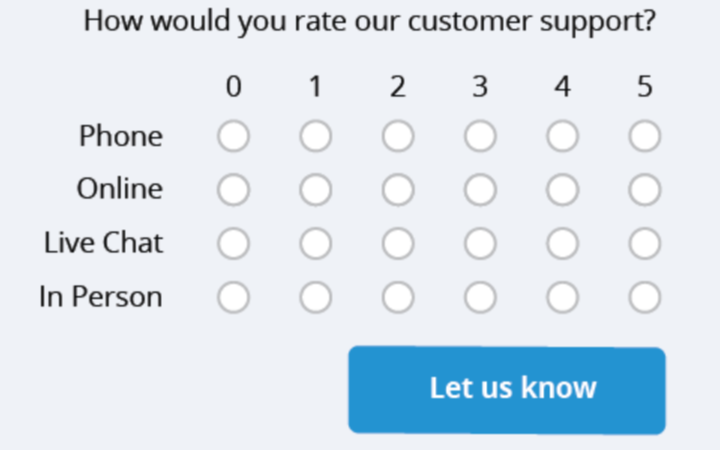
Source: Qualaroo
In the next section, let us understand the benefits of matrix questions.
Benefits of Matrix Survey Questions
As compared to open-ended survey questions and long answer type questions, matrix questions offer several benefits: reducing redundancy to enhancing survey response rates.
- Space Saving: The matrix survey is displayed using row-column format, thereby avoiding long pages of questions and answers. A good quantity of 4-5 questions with their answers are easily accommodated on a single page. Your survey respondent feels comfortable when they see only one question.
- Reduced Survey Response Time: Matrix survey questions follow a definite pattern with the same response options for every question. Hence, it is easy for your survey respondents to program their mind for answering the questions. On the other hand, there are different options for each question in a typical survey questionnaire, which can even confuse your target audience.
- Increased Survey Responses: With a clear single-page layout and easy to comprehend answer options, your respondents will be keen to take the survey, thereby increasing the survey response rate.
- Eliminates Monotony: Attending back-to-back survey questions can get monotonous if it consists of multiple long and short answers type questions. Each of these questions requires an in-depth thinking process. But, matrix question and answer eliminates monotony by grouping together the questions based on the same topic under one head. Your target audience needs to just focus on the product as a whole by selecting similar answer options.
While there are many benefits, there are also few drawbacks of a matrix survey. Let’s understand it better in the next section:
Drawbacks of Matrix Survey Questions
Matrix questions face challenges when it comes to data quality, mobile responsiveness, and so on.
- Straight Lining Effect: Though matrix survey aids in quick responses, your respondents may end up selecting the same answers for two rows without careful consideration. This may distort the survey with incorrect responses.
- Low Data Quality: Too many rows or columns in a matrix can distort the data quality by confusing your target audience. They may either give an incorrect answer or drop out of the survey altogether.
- Probability of Poor Mobile Responsiveness: Research suggests that, on average, around 30% of people respond to surveys via mobile phones. Hence, if not designed and formatted correctly, matrix questions look distorted on mobile. This can lead to high survey drop-out rates on mobile phones.
Now that you have understood the drawbacks of matrix survey questions let’s explore the types of matrix questions.
Types of Matrix Survey Questions
Matrix survey questions take various forms like matrix rating scale, text entry type, total type, etc. You can easily crete these questions using a powerful survey creation tool like ProProfs Survey Maker.
1. Single-Selection Type:
In this type of matrix survey question, the respondent gets to select only one answer(column option) per question (row option). This question is useful in the case of a single opinion concerning a particular question.
In the below example, a ProProfs customer gives their opinion on different aspects of ProProfs Survey Maker. Our customer cannot like and dislike the feature at the same time. Hence, at a point in time, only one option from a specific column can be selected.
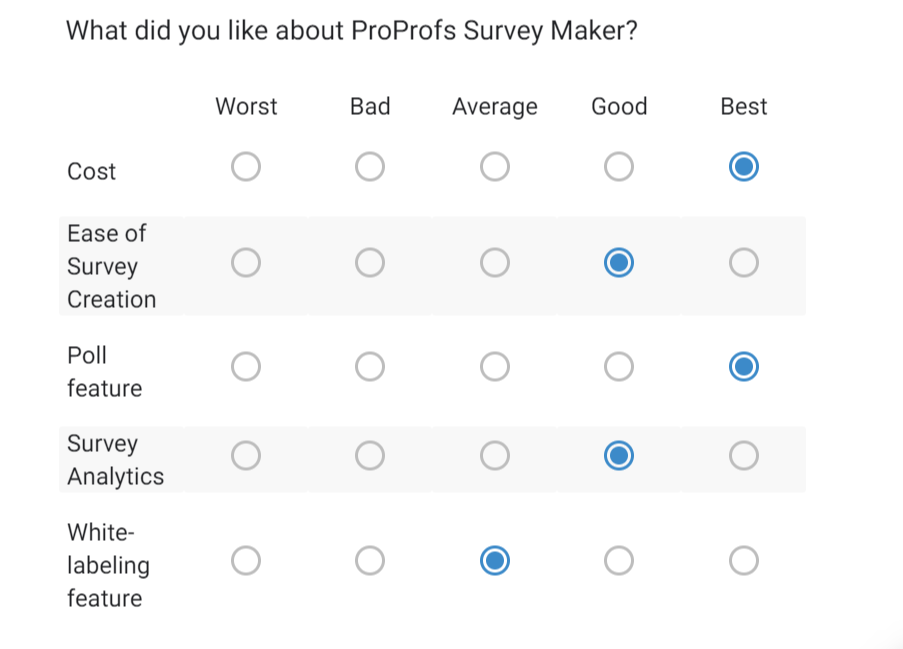
2. Multiple Selection Type:
Here, the respondents can select multiple column options in response to a row question. Use this type of matrix question when you are comparing your brand offerings with that of your competitors.
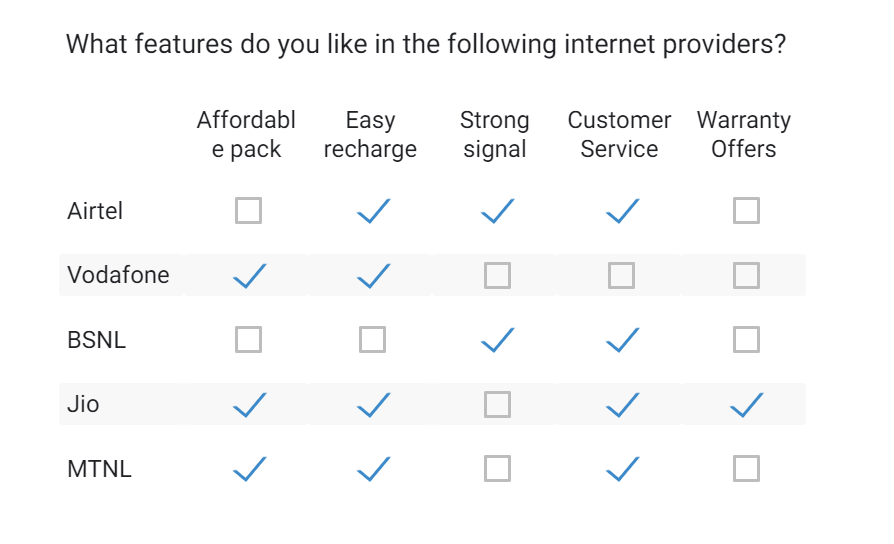
3. Likert Scale:
The Likert scale uses a 5 or 7 point scale to understand your target audience’s opinion. It can fall into different categories ranging from extremely satisfied to extremely dissatisfied. Use this type of matrix question when you want to collect in-depth details about a particular product or service.

4. Bipolar Type:
In a bipolar type matrix survey question, extreme options are given at the opposite end of the question. The respondents are asked to pick the response between the two extremes.
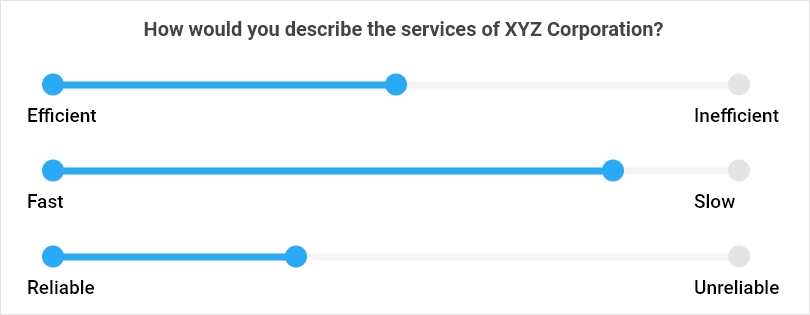
Source: Outsource2india
5. Ranking Type:
The ranking type of matrix survey questions asks your survey respondents to rank the column options based on their preference. This type of question helps when you want to compare the performance of different products in your company or ask employees about the workplaces priorities.
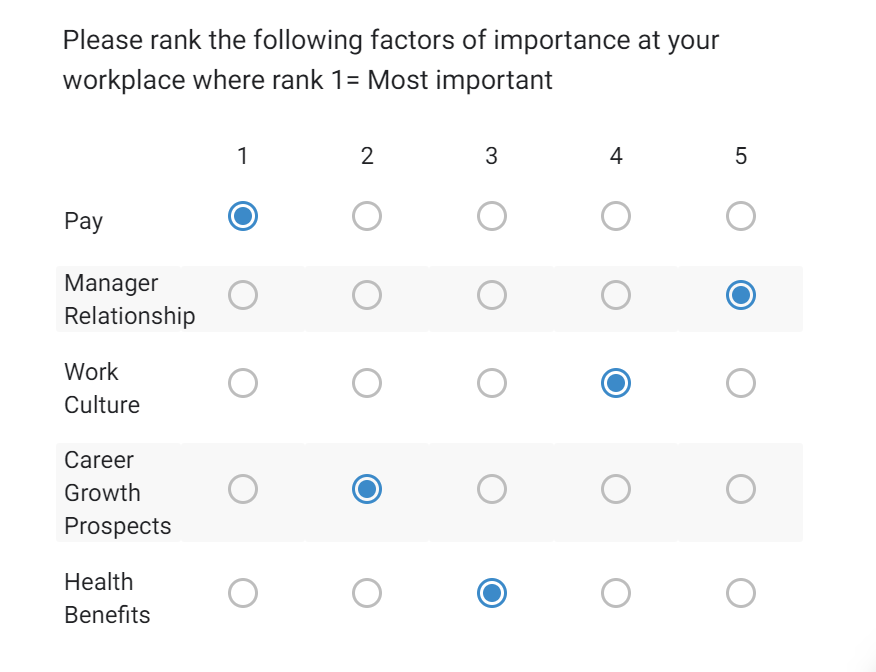
6. Comment Type:
Using the comment question type, the respondents can add additional comments while selecting their desired column (answer option). In the example below, in addition to selecting why pay is the first important factor at the workplace, employees can also add additional comments and suggestions. This additional feedback goes a long way in improving the employee experience in a company.
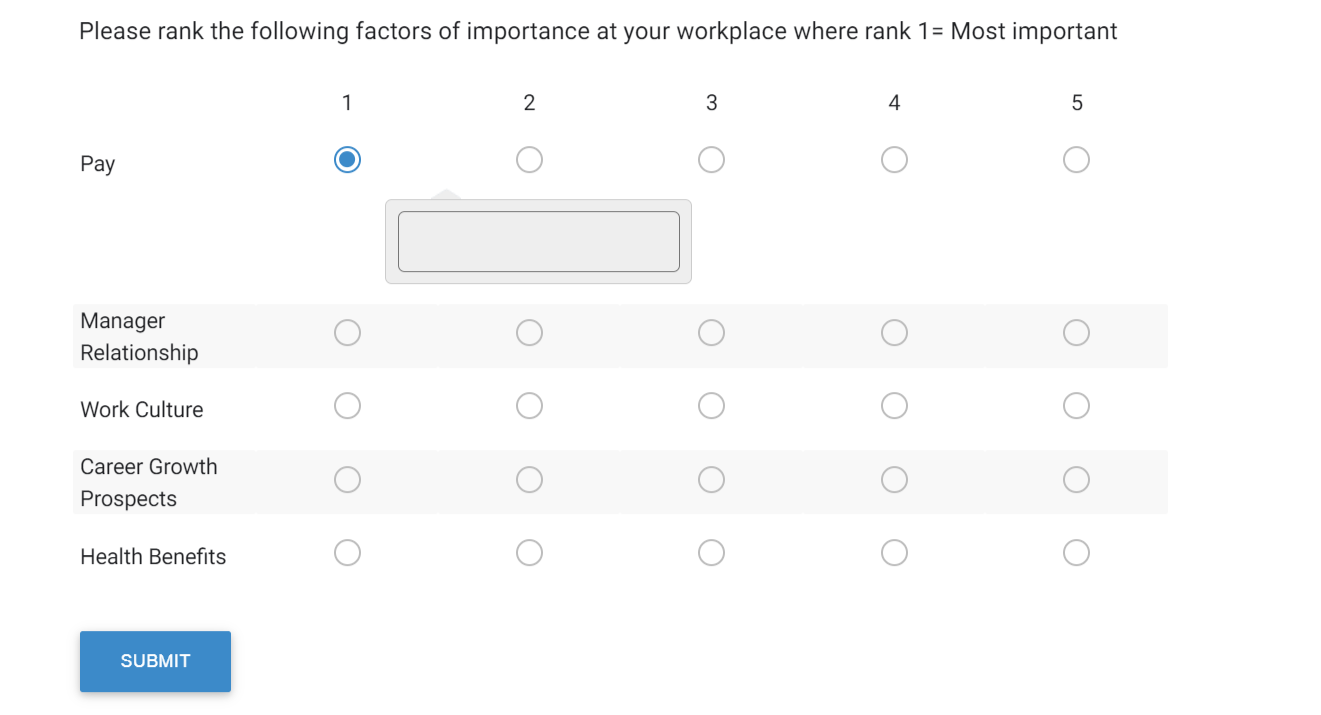
In the next section, let’s understand the answer to an important question: What are matrix survey questions used for?
When to Use Matrix Survey Questions?
Matrix survey is handy to understand your customer experience with a brand, knowing their viewpoint on a particular topic, and so on.
Customer Experience Surveys
Customer experience surveys try to understand your customer satisfaction levels in using a product/service. The survey is conducted right after a significant customer touchpoint like product purchase, six months after product usage, after a customer query resolution, etc.
Let’s understand with the help of a matrix question example. Herein, Netflix has used a matrix survey question to understand their customer experience of watching movies and shows on Netflix.
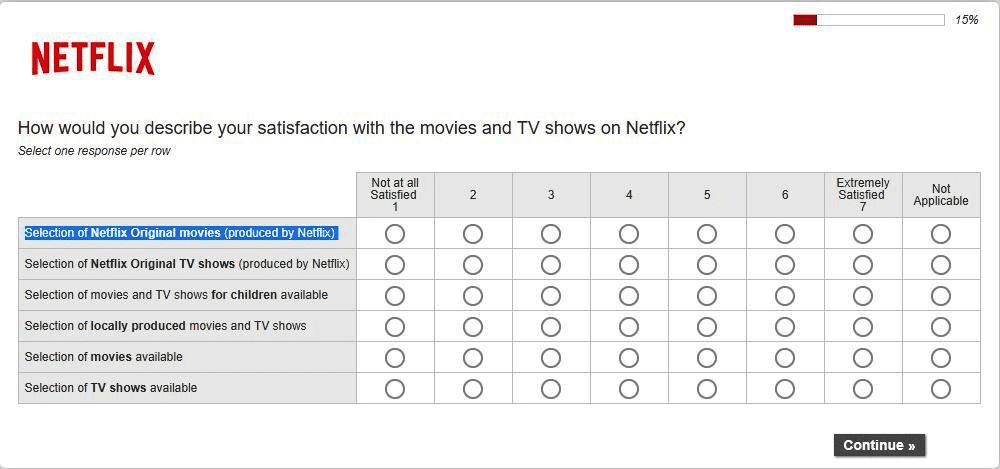
Source: Annasslant
Perception on Multiple SubTopics
Matrix questions are an excellent way to know about your target audience’s in-depth views. Regular surveys try to cover a topic on the generalistic level. But, it is not sufficient to form a clear understanding of your audience’s needs. Hence, you can take a particular aspect of your product/service and frame 4-5 matrix questions around it. Herein, you get a wholesome feedback from your target audience.
Let’s understand it with the help of some matrix survey questions examples.
An eBay visitor is asked about the reasons why he visits Ebay community pages. Here, the focus of the survey matrix is only related to the “visitor’s intent.”
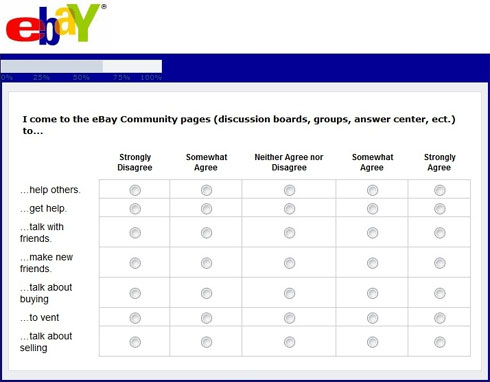
Source: Ecommercebytes
Now that you have understood the application of matrix survey questions let’s learn some tips for writing matrix questions.
Tips for Writing Good Matrix Survey Questions
While writing matrix questions, you need to make sure that it creates a good experience for your survey respondents. This motivates them to take up more surveys in the future.
- Minimum Response Options: Minimize the number of response options to 4-5. This avoids confusion, and your respondents can easily choose from the responses.
- Shorten the Response Wording: Do not overdo the response wording; keep it short and sweet. This ensures better understanding of the responses as well as creates a better mobile experience for your respondents.
- Do Not Go Beyond Five Rows: Restrict the number of questions to a maximum of five rows. Beyond this, the matrix fits clumsily on a page. And also, your respondents can get bored with the sudden bombardment of a lot of questions.
- Do Not Ask Unrelated Questions: While designing the survey, one could be tempted to ask peripheral questions that may not directly relate to a single product/service. This can confuse your customer into giving incorrect answers. Hence, keep your matrix questions restricted to a single subtopic.
- Keep Your Language Simple and Jargon Free: Use a simple language so that your target audience can understand the question in one go. Also, avoid industry jargons that may confuse your respondents.
Create Engaging Surveys with Matrix Questions
Matrix questions help you collect actionable feedback from your customers by presenting the questions on a neat column-row interface. Your customers can easily glance at the questions on a single screen and make quick decisions. This further enhances survey engagement and response rates.
Based on your requirements, you can choose variants of matrix survey questions like single select, multiple select, ranking type, likert scale, and so on. Make sure that the questions are short, simple, and jargon free. Further, keep the questions to a maximum of 5 per row and ensure the matrix survey’s mobile responsiveness.
Looking to create your first matrix survey? ProProfs Survey Maker comes with a “grid of questions” option to create matrix survey questions with ease.
Do you want a free Survey Software?
We have the #1 Online Survey Maker Software to get actionable user insights.







